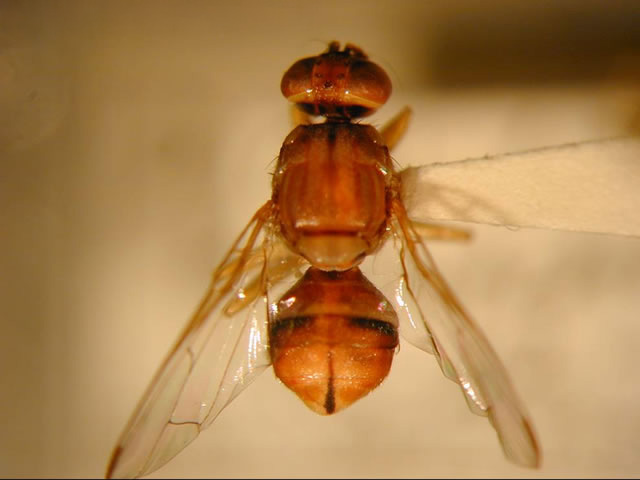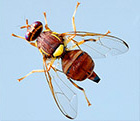Peach Fruit Fly
Pest Profile


The adult peach fruit fly (PFF) is about the size of a housefly, 5 to 6 millimeters (mm) in length. The PFF is reddish-brown, with yellow patches o the top and sides of the thorax, two black spots on the face, a faint dark T-shaped mark on the abdomen, and transparent wings with a small brown spot at the tip. The female has a pointed slender ovipositor to deposit eggs under the skin of host fruit. The white eggs are 1.1 mm long and 0.2 mm wide. The maggots (larvae) are creamy-white, legless, and may attain a length of 7 to 10 mm. The pupa is encased in a dark brown cylindrical puparium about 5 mm in length.
History and Economic Importance
The PFF is an invasive insect originating in Asia, and has been accidentally introduced into North Africa. PFF feeds on many kinds of fruit and vegetables. Important California crops at risk include pome and stone fruits, citrus, dates, avocados, and many vegetables, particularly melons and tomatoes. Damage occurs when the female lays eggs in the fruit. These eggs hatch into larvae, or maggots, which tunnel through the flesh of the fruit, making it unfit for consumption. The first California detection occurred in Los Angeles County in 1984, and since that time, several re-introductions have been delimited and successfully eradicated.
Distribution
PFF is widespread through much of the mainland of southern Asia from Iran eastward, neighboring islands including Sri Lanka, Philippines, and Taiwan, and the Arabian Peninsula. In recent years it has invaded North Africa.
Life Cycle
Females lay eggs in groups of up to nine under the skin of host fruits; the female can lay more than 500 eggs in her lifetime. The amount of time it takes for egg development depends on the ambient temperature, but is normally about two days. Maggots tunnel through the fruit feeding on the pulp, shed their skins twice, and emerge through exit holes in four to 21 days, depending on temperature. The larvae drop from the fruit and burrow 1 to 6 inches into the soil to pupate. The pupal period varies from four days in summer to over six weeks in winter. The newly emerged adult females need eight to 16 days to mature sexually prior to egg-laying. Breeding is continuous, with several annual generations. Adults feed on honeydew, decaying fruit, nectar, and plant sap. The adult is a strong flyer, recorded to travel 25 miles in search of food and egg laying sites. This ability to fly long distances allows the fly to infest new areas very quickly.
Host and Damage
A number of commercially valuable fruits and vegetables are attacked by PFF (see Partial Host List below). Fruit that has been attacked may be unfit for consumption due to the larvae tunneling through the flesh as they feed. Decay-producing organisms then enter, leaving the interior of the fruit a rotten mass.
